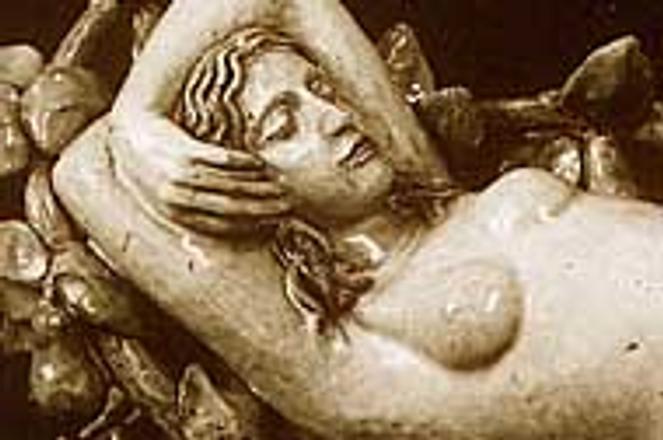FLEISCHMANN's earliest known work, Reclining Nude, 1928, is among the works permanently exhibited at Biela 6 in Bratislava.photo: Zuzana Zemanová
SOME 500 metres from London's Victoria Station stands Westminster Cathedral and its little chapel that houses the Triptych of the Holy Rosary. Carved into Perspex, it was created by Bratislava native Arthur Fleischmann, who was married there in 1955.
The world-renowned sculptor died in January 1990 at the age of 93, just two months after the anticommunist revolution opened the country's borders to the West and when the artist's dream to visit his birthplace could have finally come true.
During his nearly-70-year career, Fleischmann worked in more than six countries. However, he never managed to make it back to where he grew up - Bratislava. Fleischmann, who originally trained and worked as a doctor, left central Europe before the second world war. Fearing for his life because he was a Jew, he travelled to South Africa as the doctor for a Vienna-based ice-hockey team. The communists, who took over in 1948, made it impossible for him to return.
However, thanks to his wife Joy and son Dominique his dream has not completely vanished. On November 26, after a 12-year struggle, they will finally open the Arthur Fleischmann Museum in the very house in which he was born. Located in the heart of the capital, at Biela ulica 6, the museum will house 50 sculptures representing the entire spectrum of the artist's work.
Among the pieces to be exhibited will be his fireplace surrounded by nine glazed coloured ceramic tiles that tell the biblical story of the fall from paradise; statues and busts portraying religious motifs, actors and public figures; and fountains made of Perspex - the plastic, which, according to art critics, gave his figurative repertoire a new lease of life.
The exhibit will also include photographs and documents that map the sculptor's rich life and work. A little over half of the exhibited works were donated to the museum by the Arthur Fleischmann Foundation based in London. The rest were acquired from the collections of Bratislava museums.
LIZARDS, Perspex, 1966.photo: Zuzana Zemanová
"It's with both satisfaction and relief that the more than decade-long struggle [to launch the museum] is over," says Zuzana Francová, curator at the City Museum in Bratislava and the main force behind the project.
Fleischmann's son Dominique, 41, adds: "I feel relieved, proud, fulfilled and humbled."
The main reasons it took so long to get the project off the ground were that it was difficult to secure funding for the museum, and it was also hard to get possession of the house, because it had changed owners many times.
But before that, there was the problem of locating the house where Fleischmann had lived.
"The changes of the address of the building where my father's family lived reflect the turbulent history of the city. The street has changed its name from Biela to Schneweissgasse to Wolkrova and finally back to Biela over the last 100 years, as the city has hosted the Habsburgs, the Nazis, the Allies, the Communists, and now finally its own people," says Dominique.
Born in Bratislava in 1896 during the Austro-Hungarian empire, Fleischamnn first qualified as a medical doctor in Budapest and then, while living in Prague, he turned his attention to sculpture.
THE SCULPTOR in his studio.photo: Courtesy of GMB
In 1937, he left Europe for South Africa, where he exhibited some of his work before travelling to Indonesia. Two fruitful years on the island of Bali proved a tremendous source of inspiration for his work, before he was forced to flee to Australia when the Japanese invaded.
Arriving there at the age of 43, he had no problems fitting in with the local sculpture scene. He became a member of the Merioola artist commune and established a strong connection with Australia.
In 1949 he travelled by ship to England with plans to return to Bratislava, but he met his wife Joy in London and settled there. He soon caused a media sensation with his bronze mermaid fountain Miranda. Instead of a conventional tail he gave her beautiful legs that turned to fins only at the very end.
Even though Fleischmann had become famous in the world of sculpture, very few people in his birthplace - Bratislava - knew of this success. When his son Dominique came to Bratislava soon after communism was defeated, the City Museum's curator Francová had to think hard before recalling his name.
"The whole idea about the museum started in 1990, when Dominique visited me. He came to search for the roots of his recently deceased father, as soon as the revolution in 1989 enabled him to do so. We had some of his father's ceramic works in our museum, but his name was not telling me anything," Francová remembers.
During the long search for a sponsor of the museum, Fleischmann's story became the focus of consumer products company Henkel Slovensko's Lost Sons project, which highlights the works of creative artists with Slovak roots who left the country. The day after the museum opens, a special exhibition of the works Fleischmann created during his early years in London will open at Mirbach's Palace at Františkánske námestie 11.
ONE of the Paradise Lost fireplace tiles.photo: Zuzana Zemanová
"Bratislava is where my father was born. It's logical to put [this] museum in the place he started his life's journey. We hope to open a museum in England too," says Dominique, who despite studying mathematics and theoretical physics has tried to follow his father's footsteps, spending 1991 studying sculpture in Rome.

